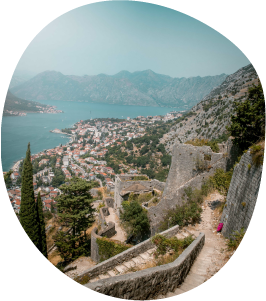VISIT MONTENEGRO
Being the perfect combination of sea and mountains, the “Black Mountain” country has many assets to quickly grow as one of the most popular European summer destinations.
Currency
€ - Euro (1€ ≃ 1,05$ ≃0,86£)
POPULATION
0,5 million
MAIN LANGUAGE
Maltese, English
AREA
316 km²
TIME ZONE
UTC+1 / UTC+2
FLAG
🇲🇪


HIKE IN DURMITOR NATIONAL PARK
This park has a remarkable diversity of landscapes and activities opportunities: sail on Crno Jezero lake, climb the Bobotov Kuk summit or water raft on Tara Canyon.

GO ON A BOAT RIDE ON SKADAR LAKE
Lake Skadar is located on the border between Montenegro and Albania. Its freshwater houses a remarkable biodiversity.

VISIT OSTROG MONASTERY
One of the busiest Orthodox churches in Montenegro is the Monastery of Ostrog, which is perched 900 meters above sea level and built into a cliff.

SOAK IN KOTOR BAY
Being the crown gem of Montenegro, the Bay of Kotor is recognized by UNESCO as a world heritage site. There, you wind medieval villages, pleasant weather, and of course, beaches.

CLIMB THE STEPS OF NJEGOS MAUSOLEUM
Located in Lovćen National Park, this is the highest mausoleum in the world. You will have to climb 461 steps to reach the top, but the magnificent panorama at the top makes for a great reward.
Pick a Montenegrin destination

Kotor Bay
Montenegro's answer to Norway's fjords.

Lake Skadar NP
Balkans' largest lake and one of the largest bird reserves in Europe.

Podgorica
Literally meaning 'under the little mountain', it is the capital and largest city of Montenegro.

Durmitor NP
The largest Montenegrin natural park.

Lovćen NP
One of the country's top landmarks, located on the mountain of the same name
All articles about Montenegro
Prepare your trip to Montenegro
💡 Why visit Montenegro?
Montenegro may be small, but it offers breathtaking natural beauty, charming old towns, and an adventurous spirit. From the dramatic fjord-like Bay of Kotor and the serene beaches of the Adriatic coast to the rugged peaks of Durmitor and the wild Tara River Canyon, Montenegro is packed with stunning landscapes. It’s ideal for hiking, road trips, and relaxing seaside escapes—all at great value.
🪪 Do I need a visa to visit Montenegro?
Citizens of the EU, USA, Canada, Australia, and many other countries can enter Montenegro visa-free for up to 90 days within a 180-day period. However, some nationalities do require a visa. It’s best to check with the nearest Montenegrin embassy or consulate for the most up-to-date information specific to your situation.
IMPORTANT NOTE: The information below is provided merely as an indication and applies for short-term tourism visa purposes only. Before your trip to Montenegro, or if you are planning to come to Montenegro for another purpose (work, studies, …), check the official information on the Montenegrin government website: https://www.gov.me/en/
⏳ Visa-free but limited to maximum 90 days for a period of 180 days if you are a citizen of one of the following countries: Albania; Andorra; Antigua and Barbuda; Argentina; Australia; Austria; Bahamas; Barbados; Belgium; Bosnia and Herzegovina; Brazil; Brunei; Bulgaria; Canada; Chile; Colombia; Costa Rica; Croatia; Czechia; Denmark; Dominica; El Salvador; Estonia; Finland; France; Georgia; Germany; Greece; Grenada; Guatemala; Honduras; Hong Kong; Hungary; Iceland; Israel; Italy; Japan; Kiribati; Kosovo; Latvia; Liechtenstein; Lithuania; Luxembourg; Macau; Malaysia; Malta; Marshall Islands; Mauritius; Mexico; Micronesia; Moldova; Monaco; Montenegro; Netherlands; New-Zealand; Nicaragua; North Macedonia; Norway; Palau; Panama; Paraguay; Peru; Poland; Portugal; Romania; Saint Kitts and Nevis; Saint Lucia; Saint Vincent and the Grenadines; Samoa; San Marino; Serbia; Seychelles; Singapore; Slovakia; Slovenia; Solomon islands; South Korea; Spain; Sweden; Switzerland; Taiwan; Timor-Leste; Tonga; Trinidad and Tobago; Tuvalu; Ukraine; United Arab Emirates; United Kingdom; United States of America; Uruguay; Vatican; Venezuela
🛂 Visa required if you are a citizen of one of the following countries: Afghanistan; Algeria; Angola; Armenia; Azerbaijan; Bahrain; Bangladesh; Belarus; Belize; Benin; Bhutan; Bolivia; Botswana; Burkina Faso; Burundi; Cambodia; Cameroon; Cape Verde; Central African Republic; Chad; China; Comoros; Congo; Congo (Dem. Rep); Cote d’Ivoire (Ivory Coast); Cuba; Djibouti; Dominican Republic; Ecuador; Egypt; Equatorial Guinea; Eritrea; Eswatini; Ethiopia; Fiji; Gabon; Gambia; Ghana; Guinea; Guinea-Bissau; Guyana; Haiti; India; Indonesia; Iran; Iraq; Jamaica; Jordan; Kazakhstan; Kenya; Kuwait; Kyrgyzstan; Laos; Lebanon; Lesotho; Liberia; Libya; Madagascar; Malawi; Maldives; Mali; Mauritania; Mongolia; Morocco; Mozambique; Myanmar; Namibia; Nauru; Nepal; Niger; Nigeria; North Korea; Oman; Pakistan; Palestine; Papua New Guinea; Philippines; Qatar; Russia; Rwanda; Sao Tome and Principe; Saudi Arabia; Senegal; Sierra Leone; Somalia; South Africa; South Sudan; Sri Lanka; Sudan; Suriname; Syria; Tajikistan; Tanzania; Thailand; Togo; Tunisia; Turkey; Turkmenistan; Uganda; Uzbekistan; Vanuatu; Vietnam; Yemen; Zambia; Zimbabwe
⛅ When is the best time to visit Montenegro?
❄️ December – February: Winter is quiet and peaceful, especially inland. The mountains offer snow sports in resorts like Kolašin and Žabljak, while coastal areas are calm and mild.
🌱 March – May: Spring brings blooming wildflowers and perfect hiking weather. It’s an ideal time to explore both the coast and the national parks before the summer crowds arrive.
☀️ June – August: Summer is hot and dry, with temperatures reaching 30–35°C (86–95°F) on the coast. This is peak tourist season, especially in Kotor, Budva, and Ulcinj. Inland areas like Durmitor offer cooler escapes.
🍂 September – November: Autumn brings beautiful colors and fewer tourists. September is still warm enough for swimming, while October and November are great for road trips and mountain hikes.
🚉 How to get around Montenegro?
Getting around Montenegro is relatively easy, though infrastructure varies:
🚌 Buses: The most common way to travel between towns and cities. Buses are frequent, reliable, and affordable, with routes connecting coastal towns, Podgorica, and the north.
🚂 Trains: Train travel is limited but scenic. The most notable route is the Bar–Belgrade railway, which passes through Podgorica and Bijelo Polje. Trains are slow but offer beautiful views.
🚗 Car Rental: Renting a car is highly recommended for flexibility, especially in the mountains or for visiting national parks. Roads are generally in good condition, but mountain roads can be narrow and winding. Traffic drives on the right-hand side, and an IDP is recommended if your license is not in Latin script.
💳 Can I use bank cards or cash for payments in Montenegro?
Cash is widely used, especially in small towns, markets, and for local services. Credit and debit cards (Visa, Mastercard) are accepted in hotels, supermarkets, and restaurants in larger towns. Montenegro uses the Euro (EUR), even though it is not an EU member.
🔌 What type of plugs and voltage does Montenegro use?
Montenegro uses two plug types: C and F. They have two grounding holes. Most European plugs work, but check compatibility before you go. Montenegro operates on a 230V supply voltage and 50Hz frequency.
If needed, you can order an universal travel plug adapter here.
🪙 Is tipping customary in Montenegro?
Tipping is appreciated but not obligatory. In restaurants and cafés, rounding up the bill or leaving around 10% is common for good service.
🥛 Is it safe to drink tap water in Montenegro?
Tap water is safe to drink throughout Montenegro.
📅 When are public holidays and store closing days in Montenegro?
Sunday is a closing day for many stores in Montenegro. National holidays in Montenegro include:
- New Year’s Day (January 01)
- Orthodox Christmas (January 07)
- Orthodox Easter (date varies)
- Independence Day (May 21-22)
- Statehood Day (July 13)
On these days, most businesses and offices will be closed, and many attractions may be shut or have limited opening hours.
🚦 What are the speed limits in Montenegro?
In Montenegro, traffic drives on the right-hand side of the road. The main speed limits are as follows:
- 50 kph / 30 mph in urban areas
- 80 kph / 50 mph on open roads
- 100 kph / 62 mph on expressways
- 120 kph / 75 mph on motorways
During adverse weather (rain, fog, etc.), the speed limits are lowered.
💬 What are some basic Montenegrin words I should know?
Montenegrin is the official language, and it’s mutually intelligible with Serbian, Croatian, and Bosnian. Here are some useful words and phrases:
- Hello (informal) = Zdravo
- Good day = Dobar dan
- Goodbye = Doviđenja
- Yes = Da
- No = Ne
- Thank you = Hvala
- Please = Molim
- You’re welcome = Nema na čemu
- Excuse me = Izvinite
- Day = Dan
- Night = Noć
- Good evening = Dobro veče
- Goodnight = Laku noć
- Mister = Gospodin
- Ma’am = Gospođa
- Street = Ulica
- Road = Put / Cesta
💡 Tip: With the GoogleTranslate app, you can download the Montenegrin language to use it even offline!
🛡️ Is it safe to travel in Montenegro?
Montenegro is generally very safe for travelers. The country is welcoming and easy to navigate. As always, standard precautions are advised:
Secure Your Belongings: Especially in busy tourist areas like Kotor and Budva.
Emergency Numbers: Dial 112 for police, ambulance, or fire services anywhere in Montenegro.










